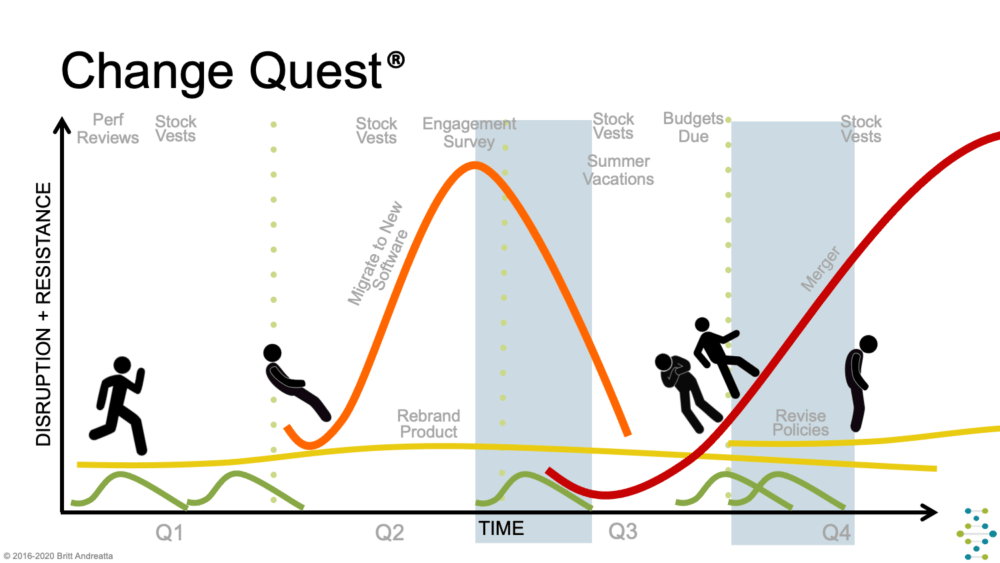5 Ways to Combat Change Fatigue and Energize for the New Year

As the year starts, we often see looming ahead of us all the changes coming our way. Change fatigue occurs when people just cannot keep up with the pace or volume of change coming their way. For small initiatives, the physical and psychological effort might be low but as more changes begin to overlap, a person's ability to successfully cope can become strained.
What are the signs of change fatigue in the workplace?
From the front lines to the top executives, you might see several symptoms, including disengagement, exhaustion, absenteeism, confusion, conflict, and cynicism. You will also likely see a decline in performance across the group, even among your top performers.
Change fatigue is real and impacting organizations in every industry around the world. More and more studies are being done on change fatigue and its effect in the workplace. For example, a study by Ketchum, Inc., of senior executives in seven countries found that nearly half (47 percent) of senior leaders felt change fatigue was highly prevalent in their organization. Tyler Durham, president of Ketchum Change states that more leaders need to "recognize the exhausting effect that continuous change and volatility has on employees and how that exhaustion can lower employees' productivity, reduce their engagement and damage retention rates."
From my own research on the neuroscience of change, I created the Change Quest that gives leaders, managers, and employees better tools for assessing the impact of change. Here are 5 things you can do to combat change fatigue.
1. Take stock of how tired you feel now.
Hopefully, you were able to rest over the holidays but for many of us, this time of year is even more exhausting because of travel, entertaining, etc. Look at the list of change fatigue symptoms. Which ones are you feeling or experiencing? Mark each of the 6 symptoms on a 5-point scale from low to high. This gives you a total possible score of 30 and the higher your number, the more you'll need to focus on the next tip.
2. Rest and recuperate.
If you're tired now, you need to get yourself in better shape before you can tackle more change. This should be a top priority. How can you build in some time to rest and recharge during January? How can you get more and better sleep? This might mean cutting back on some things to make room. Consider which social engagements can you reschedule or which projects you can delay. You might not have control over all aspects of your calendar but you do have more control than you probably think. Let people know by saying something like, "I've realized that I'm a little more run down than I'd like to be so I'm pulling back for a few weeks so I can recharge my energy."
3. Do an inventory of change coming your way.
Another important thing to do is look ahead at what's coming. While we don't always know everything, we can certainly focus on what we do know. Since biologically, our bodies don't sort change into professional and personal, you want to look at both areas of your life. All changes can be assessed using the Change Matrix, which looks at how disruptive a change will be as well as how long it will take you to acclimate to the change. This creates four color zones and here is an example.
First, let's look at how disruptive various changes might be. How much disruption does each change create for you? Some completely disrupt the day-to-day flow while others have a negligible impact. Consider these questions.
- Does a change impact how and where you will do your work or live your life?
- Does it impact your relationship network at home or at work?
- Will it require new skills and habits?
Do you have to give up well-grooved habits to shift to new ways of doing things?Next, look at how long it will take to acclimate to each change and get to the "new normal" after the change is complete. Some changes can be acclimated to very quickly (hours or days) and others can drag on for months or even years. These questions will help you place various changes on the matrix and determine what "color" they are.
4. Map the next 12 months of your change journeys.
Now, let's create a timeline for 2019 so we can see what is going to happen when. Take a sheet of paper and draw time along the bottom. I like to indicate the four quarters and some folks like to add the months. The color zones from the matrix become the shape of the change journey, with red and orange changes becoming like mountains we have to climb. Yellow changes are long but not steep and green become little bumps. My research indicates that big changes are hardest at the beginning but inevitably we get "over the hump" or peak and things start to feel easier. Map your changes on the timeline, indicating when you think they will start and finish and where you think the peak will be for big changes. If you want, you can add some notes along the top for "rhythm of business" elements like annual reviews and budget submissions and some "rhythm of life" elements like vacations and taxes.
5. Assess and make adjustments.
By mapping your changes across the year, you can now see some critical things. First, look at the year and circle times when you are carrying several changes at the same time. We do have a biological limit for how much change we can hold at the same time without experiencing fatigue. Are there any intense times on your horizon? And more importantly, could you move the start date for any changes or combine other changes to make things better?
After you have adjusted what you can, the final step is to circle or highlight the times when things are going to be the most intense. Look at how much time you have to recover from a big change before the next one starts. People often have change fatigue when orange-, and red-zone changes are strung together without sufficient recovery time in between. In fact, like the proverbial straw that broke the camel's back, even one or two ill-timed green changes can also do damage.
These are the times when you need to be intentional about how you support yourself so you can thrive despite being overwhelmed.
Consider how you could dial up self-care and cut back on other things like traveling or entertaining. Also, think about who might be able to help. When I'm moving through intense times of change, I'll partner with co-workers so we can help each other our. And I schedule more time with my close friends and more sessions with my therapist. I also lean on other working parents for rides knowing I will return the favor when they are swamped.
In fact, I recommend doing this change assessment activity with your immediate family and closest colleagues. It will help you support each other and also give you a process for making choices about the changes that are flexible.
While adapting to change is an ever-growing part of our lives these days, all of these strategies will make you feel more empowered and will help keep change fatigue at bay. But when you do get fatigued (it's inevitable because things unexpectedly drop onto our timelines), cycle back to #2 and focus on resting and recuperating as much as possible.
If you'd like to learn more about the biology of change or my Change Quest® , here are some options:
Related Blogs
JOIN OUR COMMUNITY
Be the first to know of Dr. Britt Andreatta's latest news and research.






